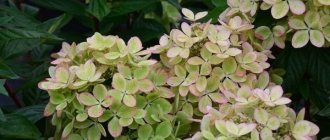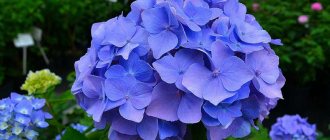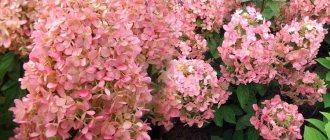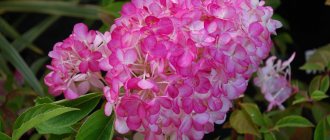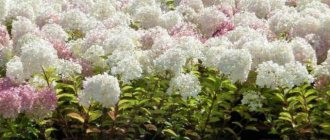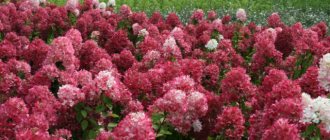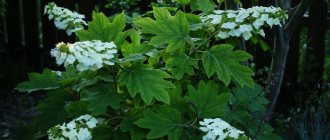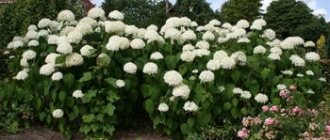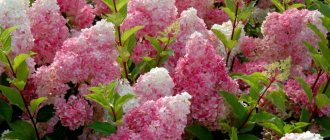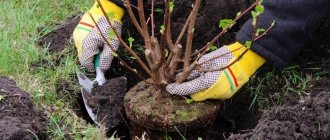Origin of hydrangea Frize Melba
Hydrangea Fraise Melba is a new product from the collection of the French selector Jean Reno, bred in the 20th century. The appearance of the hybrid flower was preceded by a long (10 years) and painstaking work. The name of the variety is given in honor of the strawberry dessert with cream due to the pyramidal shape of the inflorescences, white at the top and red at the base.
Hydrangea Frize Melba - a new hybrid shrub
History of the creation of the hybrid and technical data
This type of hydrangea, Fraise Melba Renba, was developed in the mid-20th century. Jean Reno. Then the breeding activities of scientists concentrated on obtaining the paniculate Vanilla variety. Many years of experiments ended in 2014 with the creation of the hybrid hydrangea Fraise Melba, which immediately gained worldwide popularity. The reason for this is the ability to breed it in different climatic conditions.
Technical characteristics of the plant:
- The height of the bush ranges from 1.7 to 2.1 m. The branches are rigid, almost straight, painted burgundy with a brown tint.
- The leaves are ordinary, narrow, with a serrated structure of raised edges, and are egg-shaped. They form a “boat”. Painted in dark shades of green.
- The inflorescence looks like a pyramid. The average length is 0.3-0.4 m, and with appropriate care the size increases to 0.45-0.55 m.
Description of colors:
- they are densely located throughout the cone;
- the initial milky color of the petals first becomes pink and then acquires a crimson color;
- when blooming, the inflorescence retains white tones;
- at the beginning of autumn, some types of this hybrid change the color of the tips of the petals.
This hydrangea blooms at the end of July, and the process continues until late autumn. Frez Melba hydrangea is not afraid of extreme cold. This variety grows quickly. To obtain large inflorescences, the summer resident must prune the hybrid in early spring.
Important! If the petals of the plant are dried under the rays of the sun, they retain their original aroma for a long time.
Peculiarities
Incredibly beautiful long-lasting flowering, ease of care and high frost resistance have earned hydrangeas of this variety well-deserved fame. From the description of the varietal characteristics, it immediately becomes clear that the shrub is ideally suited for cultivation in the climatic conditions of our latitudes.
The unusual color scheme of luxurious inflorescences, reminiscent of one of the French favorite desserts, strawberries and cream, is the main idea of the head of the breeding group, Jean Reno. His ten years of painstaking work to create this variety was crowned with success. Cone-shaped, very large inflorescences of the hydrangea “Fries Melba” are formed on the tops of strong shoots in the form of a dense panicle of small flowers located close to each other. Flowering continues from mid-July until cold weather. With suitable soil and proper care, panicle flowers grow up to 45–55 cm.
The color of the inflorescences changes over the course of the season. At the beginning of flowering, the inflorescence is milky white, gradually turning pink, harmoniously turning into a rich wine-red color at the bottom of the panicle. The top of the inflorescence always remains white.
A mature bush grows approximately 2 m in height and width. It does not look bulky on the site, since the strong, erect stems without branches do not fall apart, the bush does not require staking and looks compact. The color of the shoots ranges from rich dark burgundy to brown. The plant is deciduous. The leaf plate is dark green, shiny, shaped like a boat, attached to the shoots with spectacular petioles of bright coral color, which gives the bushes additional decorativeness.
Descriptions of hydrangea Frize Melba
Hydrangea Melba Frazee is a paniculate ornamental shrub reaching a height of 2 m, looks compact and does not require garter. The branches of a young plant have a dark red tint, becoming brown over time. Round green foliage, pointed at the edges, is attached to the shoots with long petioles. Branching on straight growing shoots is excluded.
Large openwork inflorescences (40-55 cm long), similar to a pyramid, change color during flowering: pink petals turn white, light petals become brown, the upper part remains white.
The peak flowering of the Frez Melba hydrangea occurs in mid-summer, lasts until frost, and no fruit is formed. Inflorescences appear annually, immediately after planting. No additional care is required for the hybrid. The plant lives 30-40 years.
Interesting fact. It is unlikely that hydrangea will become diseased; Frize Melba is a resistant variety. Diseases develop when growing a flower in a corner with a lack of sunlight, lack of fertilizers, and lack of access to fresh air. The novelty is also of little interest to insects.
The disadvantages of the crop include the difficulty of obtaining seeds and susceptibility to fungal diseases. The variety does not cope well with drought and rots when there is an excess of moisture.
Decor of garden paths with hydrangea Frez Melba in the Urals
General information
Hydrangea Frize Melba blooms profusely from spring to autumn. The color scheme of the hybrid gives unusual transitions from crimson to white shades, decorating the edges of the petal part, elongated in the shape of an elongated pyramid.
A distinctive feature of the plant is its flowering in the first year after planting. Moreover, this process occurs regardless of the condition of the bush. No additional care is needed for the hybrid. The paniculate form of Frize differs from its ancestors in its increased frost resistance and the ability to change color throughout the year: pink petals turn white, and light ones acquire a crimson color. The plant can live 30-40 years
Hydrangea Frize Melba
Botanical description of the variety
Paniculata hydrangea is an ornamental, profusely flowering shrub, frost-resistant and unpretentious. The Fraise Melba variety was obtained by the French breeder Jean Reno. The variety was presented at the Moscow exhibition in 2014.
Work on the Fraise Melba hydrangea lasted for 10 years. The variety got its name from the famous strawberry dessert. The shrub produces large pyramidal inflorescences that change color from white to burgundy. The contrast between the white top and red base is reminiscent of strawberries and cream.
Paniculata hydrangea Freise Melba reaches 2 m in width and height. The bush has a compact appearance. The shoots are erect, brownish-burgundy in color.
The leaves are small, petiolate, located along the entire length of the shoots. Inflorescences form at the tops. The flowers are sterile; after flowering, no fruits are formed.
Important! Flowering of the Fraise Melba variety begins in mid-July and lasts until the end of September. Inflorescences are 30-40 cm long, with good agricultural technology they reach 55 cm.
Paniculata hydrangea looks good in single plantings, on lawns, and next to ornamental shrubs. It is used to decorate garden plots, greenhouses, parks and recreation areas. The Freise Melba variety is suitable for creating a hedge.
Hydrangea Frize Melba: features of the variety
The variety became widely available 5 years ago. Gardeners who have been growing hydrangea Frize Melba for several years note that it is a fairly large shrub. Indeed, according to the characteristics of the variety, the height of the plant can reach 2 meters. At the same time, not too branched, as well as strong and tough shoots allow the bush to maintain a compact shape and neat appearance.
The branches are dark in color, closer to burgundy. The shoots become woody and brown with age. The leaves of the shrub are dark green, shaped characteristic of hydrangea, slightly pointed at the top and wedge-shaped at the base, firmly attached to the branches by petioles.
Selection and varietal characteristics
The plant was bred by domestic breeders quite recently - only in 2014. By now, however, this Hydrangea Paniculata has already won the hearts of numerous gardeners, as well as several medals at exhibitions. Let us note the unpretentiousness of the plant, increased frost resistance and, at the same time, surprisingly luxurious flowering.
External description
The shrub is tall - it stretches two meters, however, it is quite compact in width and does not take up too much space in the garden bed. The shoots are very tough and branch weakly: thanks to this feature, the bush does not fall apart and does not need garter.
At the beginning of growth, the shoots are colored burgundy; as they mature, they become brown. The foliage has a characteristic oblong shape, dark green in color.
Bloom
Individual flowers of small diameter are collected in very lush, representative inflorescences. The shape of the resulting caps is cone-shaped with a narrow part at the end. The length of the inflorescences reaches 40 cm, sometimes 55 cm.
The color of the flowers is interesting: at first they are milky, gradually acquire a pinkish tint, and by autumn they turn into rich red with a wine undertone. The top of the inflorescence always remains white, while the lower part darkens (see photo). The middle is therefore pink. The result is a kind of gradient, very attractive and unusual. The flowering period begins in mid-summer and continues until autumn frosts.
A remarkable feature is that flowering occurs literally in the first year after planting. And in subsequent years, even if the bush was damaged by frost during the winter, it will bloom in any case.
But in order for hydrangea to bloom magnificently, it requires pruning. This is probably the only condition that cannot be neglected in this case. Pruning should be annual and include several stages.
pros
- The plant is distinguished by its rare immunity to pests and diseases.
- Hydrangea does not make any special demands on the substrate and does not require garter or support.
- Can grow in partial shade.
- Given very high growth, it takes up little space on the site.
- Outwardly it looks unusual, elegant, and adds zest to any flower garden.
- The flowering period is long.
- Care is easy, the plant is not capricious.
- High resistance to frost, which is very important in our climate. The best option for growing in the difficult climate of the Urals or Siberia.
Application in landscape design
Hydrangea variety "Fries Melba" is loved by many connoisseurs of exquisite phytodesign. It is used in decorating gardens and parks when creating hedges, landscape compositions and single plantings. The “Fries Melba” type combines well in plantings with phlox and sedum; ensembles with other varieties of hydrangeas and rhododendrons are very effective. Landscape designers do not recommend planting more than 3-4 hydrangea bushes in separate flowerbeds, and with “Fries Melba” it is better to plant 2-3 bushes of other varieties of hydrangea with different petal colors. Single planted "Fries Melba" looks impressive on lawns.
Reproduction of hydrangea Frize Melba
Propagation of paniculate hydrangea can be carried out in many ways: cuttings, layering, divisions and seeds. The first of them is considered the simplest and most productive method of obtaining new plant specimens.
Cuttings
The plant will take root well if you follow the basic recommendations for cuttings. Experienced gardeners cut sprouts from the bush in the early morning or in cloudy weather. Green cuttings 10 cm long are cut from annual shoots, leaving the upper leaves shortened by a third with several buds. The shoots connected by a bunch at the bottom are treated with a growth stimulator, the upper cut is disinfected with brilliant green and planted at an angle in containers.
The substrate for shrubs is prepared on the basis of turf, peat and sand, in a ratio of 1:3:4. The cutting is placed in a dug groove 5 cm deep. The soil is first disinfected in the oven at a temperature of 200 degrees. A more convenient option would be to use ready-made soil mixture for azaleas.
The sprouts are covered with glass jars and ventilated weekly for 15 minutes. Over the course of a month, the cuttings take root and the cover is removed. In areas with a mild climate, the shoots are planted in moist loamy soil; in winter, the shoots are carefully covered. In the northern climate zone, rooted hydrangea is left in a cool room until next spring.
Growing conditions
Let's find out where to place this hydrangea on the site, what conditions need to be maintained for its health and beautiful flowering.
Lighting and location
The plant has no special complaints about the choice of its location: planting the Fraise Melba hydrangea is permissible both in partial shade and in the sun. It is important, however, to protect the flower from direct sun during the midday hours. Strong shadow is not suitable.
Since this is a hydrangea, soil moisture levels are very important. Choose a place so that the roots of the flower remain moist for a long time. Dry areas are only permissible if you have the opportunity to water the plant frequently.
Temperature
In general, the plant is frost-resistant. Bred by domestic breeders, this hydrangea can withstand frosts down to -30-35 degrees. And this is without shelter. If in your region the frosts drop even lower in winter, take care of covering the hydrangea in the fall.
Also make sure that the flower is protected from gusty winds and drafts. Hydrangea does not like sudden changes in temperature. It is optimal to plant it under the protection of a house wall or fence on the north side.
Humidity
This flower will not survive without moisture - like all hydrangeas, Fraise Melba is very dependent on water. Plant it in well-moistened soil (but not waterlogged!), and do not forget about regular watering during the growing process. If the summer is hot, daily watering is required - only this approach will preserve the health and external beauty of the plant.
Priming
This beauty should be grown in a fertile substrate, with a predominance of clay. The soil should be slightly acidic - this will ensure the brightness of the buds. By planting the plant in alkaline, calcareous soil, you will get nondescript inflorescences of a pale shade.
So, we found out what the Frize Melba hydrangea is. This amazing shrub amazes with its exquisite beauty and unusual gradient flower caps. Due to the fact that the variety is domestic, it is unpretentious and adapted to the conditions of our climate, environment and soil.
Landing and seat selection
When choosing a place for planting hydrangea "Fries Melba" you need to consider:
- Illumination;
- Soil moisture;
- Wind protection.
This unpretentious plant thrives in both sun and partial shade. But it is advisable that at noon the sun’s rays do not fall on the young bush. The location is chosen so that during the day the plants are protected from direct rays. Also, you should not plant the bush in a heavily shaded place.
You cannot choose wetlands for planting. The ideal place for the plant is where the soil remains moist for a long time. But even in dry areas, the Frize Melba hydrangea can grow provided it is watered regularly.
It is advisable to choose a place for the bush that is protected from strong gusts of wind. A fence or wall of the house is suitable for protection.
Paniculata hydrangea Frize Melba is planted in the spring, when the soil is warm enough and there are no frosts.
For the plant, it is necessary to dig a planting hole with a diameter of at least 50 cm and the same depth. The hole is spilled with water, and the next day they begin planting.
It is necessary to lay a drainage layer of broken bricks at the bottom of the planting hole, and then fill it with nutritious soil. It is recommended to add to the soil removed from the hole:
- Peat;
- Humus;
All components are taken in equal parts. The hole is filled 1/3, the roots of the seedling are straightened in the hole and covered with prepared soil. After planting, the plant should be watered and shaded for 2-3 weeks.
Planting hydrangea Frize Melba
In order for Hydrangea paniculata Frize Melba to actively develop, it needs to be provided with proper planting and care.
Recommended timing
Plants of this variety should be planted in the spring, when the last frosts have gone. By this period, the soil is already well warmed up, and constant heat is established outside.
Where to plant paniculate hydrangea Frize Melba
To plant paniculate hydrangea Frize Melba, you can choose either a sunny open place or partial shade. The best option for this variety is a bright area that is shaded during the hot midday sunlight. The crop must be planted in the shade.
To prevent the shrub from breaking due to strong winds, you should plant it near the fence. Constant drafts can cause plant disease.
Selection and preparation of soil and planting material
The land for planting must be fertile. It is best to choose a loamy soil substrate. The soil should have a slightly acidified pH environment. You should not choose land that contains a large amount of limestone or sandstone.
Planting material must be kept in a cool place until planting.
Step by step planting process
Planting of hydrangea Frize Melba is carried out in the following sequence:
- Dig a hole with sides of 50 cm.
- Fill with drainage made of broken brick or expanded clay (10-15 cm).
- Pour a mixture of turf soil mixed with peat and sand. To constantly maintain soil moisture, it is advisable to add hydrogel.
- When planting in the spring, it is recommended to remove young shoots by 3-4 buds, without wasting the plant’s energy on the development of shoots; initially, the crop should grow roots.
- The roots of the seedling are well moistened in the purchased pot.
- The sprout is placed vertically in a wet hole, sprinkled with earth, leaving the root collar on the surface of the soil.
- The soil around the shoots is compacted and watered with two buckets of water.
Planting a sprout takes a minimum of time and does not cause difficulties even for beginners.
The first flowering of the shrub after transplantation
Planting process
Having placed the shrub in one place, they expect a very long growth period, up to 40 years.
This is facilitated by the correct choice of conditions and soil preparation. It is necessary to ensure a healthy composition of the soil and increase the acidity by adding appropriate components. The plant is obtained in the form of a seedling formed by:
- cuttings;
- layering;
- dividing the bush (very rare).
Seedlings and their preparation
As a result of germinating your own seeds, you will not be able to propagate hydrangeas, because panicles do not produce them, as mentioned above. But seedlings are prepared by cuttings - this is the easiest way. When pruning in spring, the shoots removed from the bush should be left and cut into 15 cm pieces. Having buried them in a box with nutrient soil, they wait for rooting. The following spring they are transferred to the garden, and in winter they are kept in the house.
Planting a seedling in the ground
A Melba Fries hydrangea seedling should reach the age of 4 or 5 years. Then you can expect flowering next year. Younger specimens will grow shoots and roots. Therefore, it will take some time before flowering.
Preparation of planting material: shoots are cut in the required quantity and rooted in a bed allocated for this. When replanting a hydrangea, they divide the bush, resulting in new plants.
Planting Melba Frize is done as follows:
- In the chosen location, dig a hole 50 cm wide and 40 cm deep. When planting several bushes, make a distance between them of 2 meters.
- Prepare the mixture:
- 2 parts of fertile land;
- 2 parts peat;
- 1 part each of sand and compost - these components must be mixed, increasing acidity is achieved by adding spruce sawdust.
- The prepared substrate is poured into the hole.
- Planting is done 1 or 2 weeks after the soil shrinks. Having carefully removed the bush from the container, transfer it with a lump of earth into the hole.
- The roots should be straightened a little, then covered with soil.
- Compact the soil and water it.
After planting, Fraise Melba hydrangea needs protection from the sun, for which a canopy is made or a paper cap is installed at noon.
Hydrangea aftercare
In order for the Fraze Melba hydrangea to continue to delight its owners with its beautiful blooms, it needs to be provided with the care it needs. The main conditions for maintaining the life of this variety are watering, pruning, mulching and fertilizing.
Watering
This variety, like all hydrangeas, is a moisture-loving crop, so proper watering is the most important element of agricultural technology. In a dry summer, without watering, the bush will dry out. Abundant watering is necessary 3-4 times a week. In hot, dry times you will have to water daily. However, you should also not over-moisten the soil to prevent rotting of the roots. In rainy weather, depending on the intensity of the rain, watering is reduced or stopped altogether.
Feeding
The Fraze Melba variety is fed with organic matter and mineral complexes. Several treatments are carried out during the season.
Feeding scheme for hydrangea Frize Melba:
- before buds open in spring;
- at the beginning of budding;
- in midsummer;
- in the fall before preparing for winter.
Features of care
Let's find out what kind of care will ensure the successful functioning and long flowering of this magnificent ornamental shrub.
Watering
Since the root system of the plant is superficial, it cannot take moisture from deep layers of soil. Therefore, regular and sufficiently abundant watering is so important when growing a flower. Watering should begin in the spring, as soon as the buds begin to form, and end only before snow falls in the fall. Before wintering, it is recommended to moisten the plant especially abundantly: this will increase the frost resistance of its roots.
The average frequency of watering in normal weather is twice a week. If it is too dry and hot outside, watering is carried out after 2-3 days. And in damp, rainy weather, it is better to postpone the next moistening procedure in order to prevent the formation of a swamp in the flowerbed.
The water should be soft and not too cold. Pre-settle tap water, otherwise, due to its high chlorine and lime content, it will quickly make the soil alkaline.
Important: after watering, it is recommended to mulch the soil in the flowerbed. This technique will help keep the roots moist for a longer period.
Top dressing
In early spring, you need to feed the hydrangea with a complete complex fertilizer. During the period of bud formation, a second feeding is carried out using fertilizers with a low nitrogen content. In the fall, it is recommended to add potassium and phosphorus to better prepare the plant’s roots for the upcoming cold weather.
Trimming
Hydrangea Frize Melba is pruned annually. The procedure is carried out in the spring, choosing the time early, before the sap begins to flow. When pruning, you should shorten all shoots of the bush by about a third of the length, if the branches are damaged, then even more. Be sure to get rid of shoots that grow inside the crown and are frozen over the winter, weak, or rotten.
Keep in mind that flower buds are formed in this case on last year’s shoots and the current year’s. Therefore, you can painlessly and without consequences part with all shoots older than two years of age, and one-year-olds and shoots with new buds should be left as much as possible.
Note that the plant tolerates a haircut easily and quickly recovers after it, increasing its previous volume and splendor. On the contrary, after regular pruning the bush seems to come to life, becoming more beautiful and elegant. In addition, it already gets rid of many pests and diseases by removing old broken branches.
If high-quality shoots remain after pruning, they can easily be used for further rooting. This is exactly what most competent gardeners do. Note that semi-lignified hydrangea cuttings take root almost 100% after cutting.
Diseases and pests
The Frize Melba variety is immune to diseases, but errors in planting and care can lead to unpleasant consequences. Fungal diseases and rot affect hydrangea if it is planted in the shade and on marshy soil. Constant cold winds and drafts reduce plant immunity. To prevent fungal diseases in spring and autumn, hydrangea must be treated with the preparation “HOM”. Insect pests (snails, weevils, bedbugs, aphids) are destroyed with insecticides. It is important to constantly monitor the condition of the plant. If any symptoms appear, you must immediately take effective measures, and not rely on the Russian “maybe” and do not wait for the disease to take over the entire bush.
